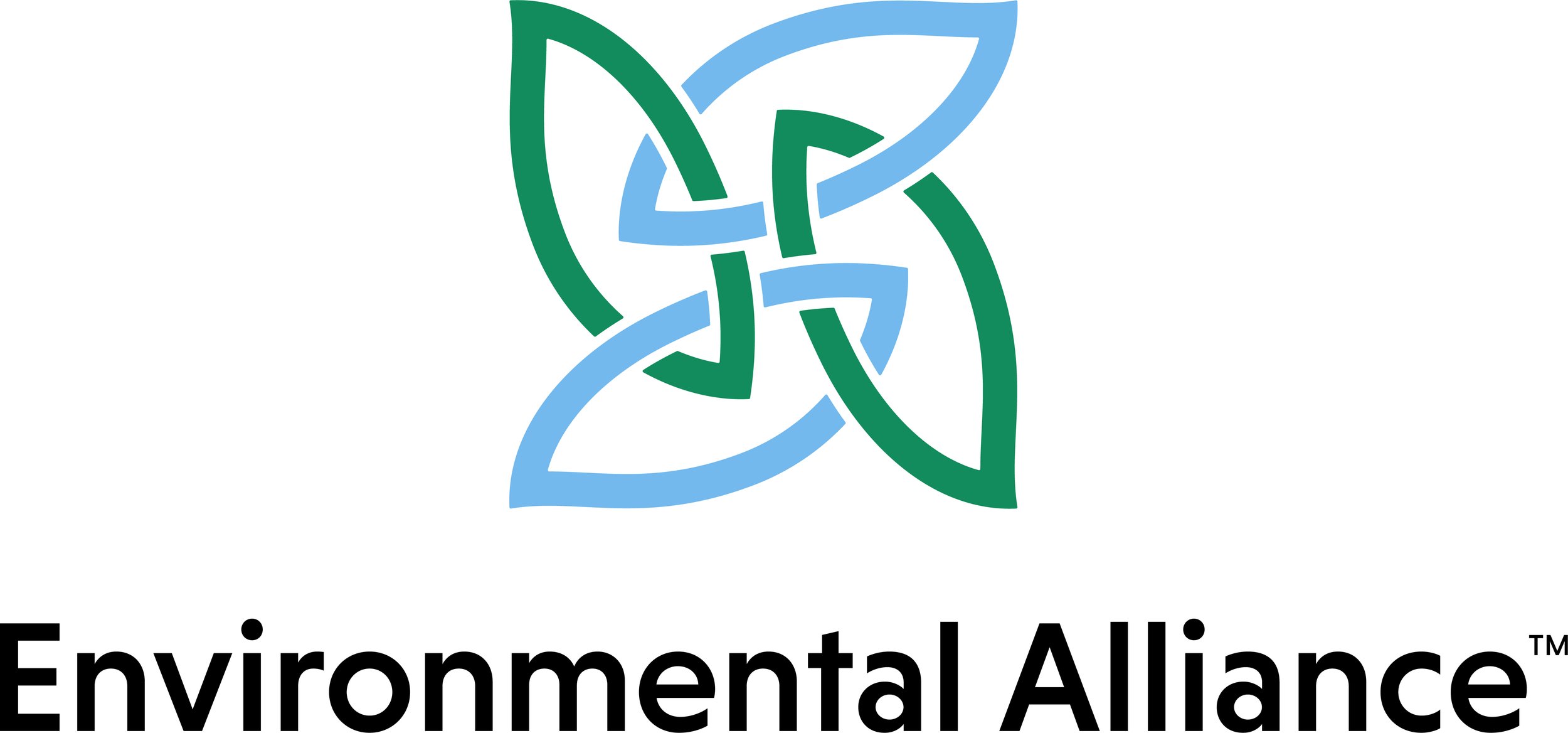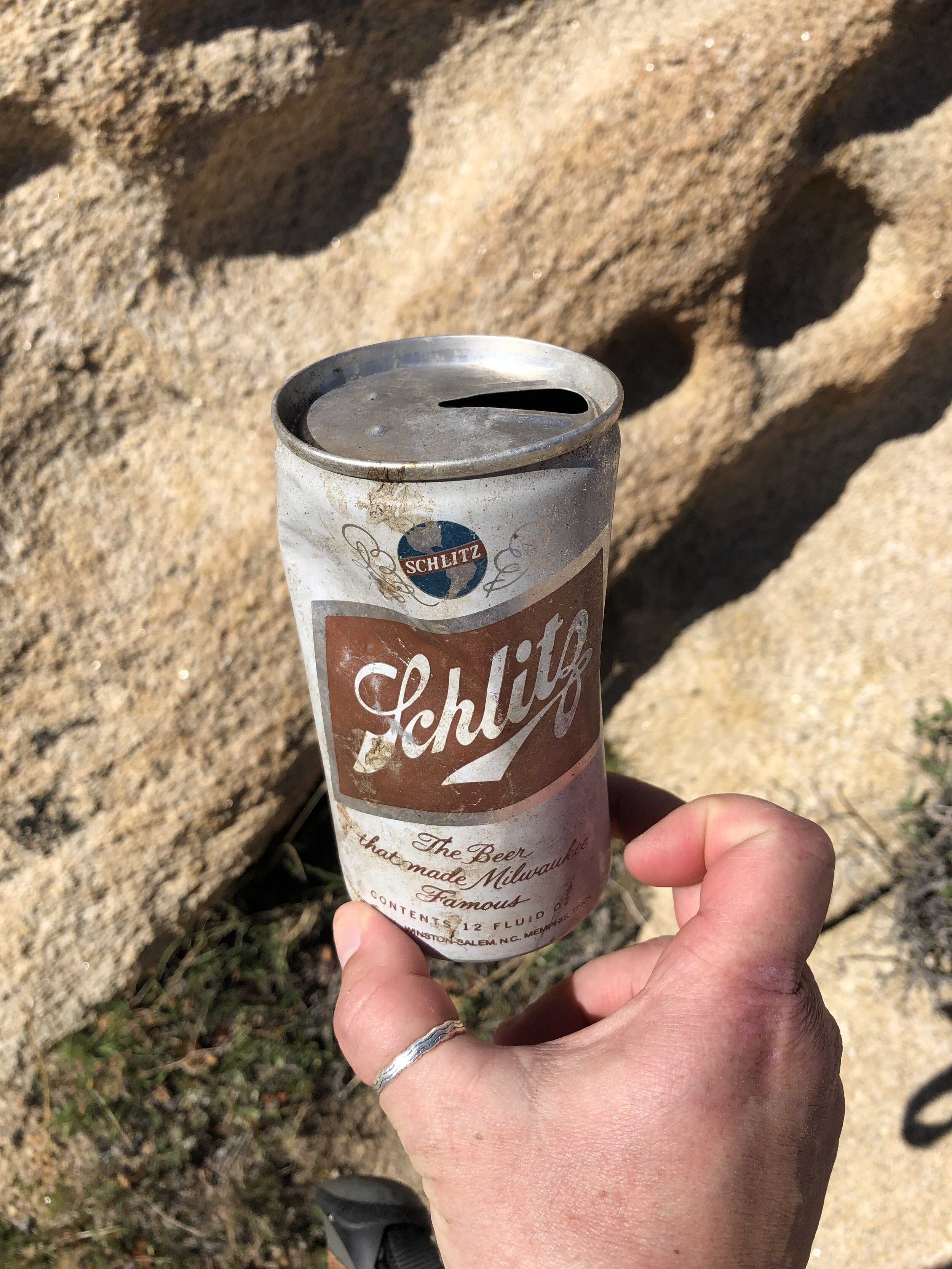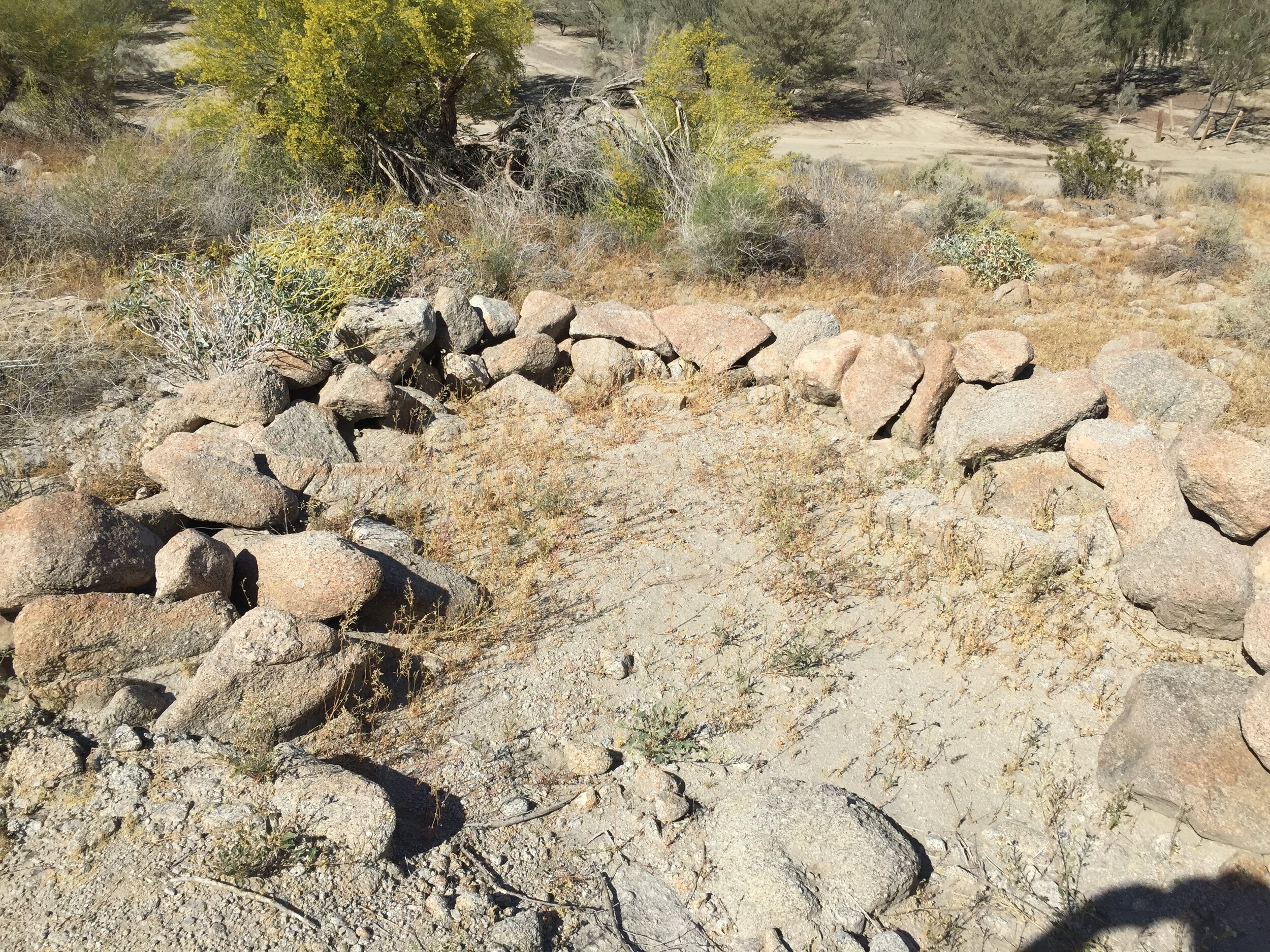Leave Some Trace: The Archaeology of Trail Trash
It was a blazing afternoon in the Coachella Valley as my fiancé, Josh, and I explored a large bajada near the Salton Sea. Brass ammunition casings and broken glass sparkled like diamonds in the sun as we stopped to inspect a bullet-riddled billiards table, now home to a family of packrats.
I picked up an aqua-colored glass bottle base and scoffed, “what the hell is wrong with people?” Josh nodded and said, “there’s so much trash. You’d need a whole crew to clean this up.”
When we returned a couple of years later, we found the Bureau of Land Management had brought in that cleanup crew; the massive piles of construction trash and the packrat-billiards table were gone, but the aqua-colored glass bottle base remained, and it was not due to oversight.
This time I did not see it as trash, but rather, as a protected cultural resource.
Billiards table dumped on Bureau of Land Management lands in the Coachella Valley
Years of hiking in Southern California has made Leave No Trace (LNT) ethics a deeply ingrained part of my moral code. But when it came to repairing impacts left by others, Leave No Trace principles did not provide me with an understanding of what was trash and what was a protected artifact.
As a result, I fear I probably packed out a few things that should have stayed.
Completing the San Diego City College Archaeology Program not only helped me identify protected cultural resources, but it also shifted my perspective on trash in general. From Native American potsherds intermingled with weathered beer cans to discarded items in illegal immigration corridors, the garbage we leave behind tells our story; effectively managing it in the wilderness requires more than just packing it out.
Archaeologists study people through the artifacts they leave behind, which is often trash. But what is an artifact, and what makes it a protected cultural resource?
The Society for American Archaeology defines artifacts as “objects made, modified, or used by humans,” which is extremely broad. In contrast, Principle #4 of LNT ethics gives a very narrow example of what artifacts are and how we should interact with them:
“…It is illegal to remove or disturb archeological sites, historic sites or artifacts such as pot shards, arrowheads, structures, and even antique bottles found on public lands.”
While there is an apparent difference between a Native American projectile point and a Clif Bar wrapper, for those like me who primarily hike in the backcountry, sometimes discerning trash from an artifact is difficult.
On a cool, autumn day, I was cross-country hiking in the Colorado Desert, when I stumbled upon a historic railroad campsite. I set my pack down and noticed an abundance of Native American potsherds in the dirt below a set of deep, cylindrical mortars, indicating this was a Kumeyaay village long before the railroad.
I treaded lightly around noticeable artifacts like rusted nails and historic medicine bottles, careful to leave no trace when I spotted a Schlitz beer can in a bush. While not new, the can did not seem to fit with the rest of the artifacts, and I was unsure if it belonged there.
Armed with my new understanding of archaeology, I knew the can’s presence in the site meant that even if it did not belong there, I was not the proper person to remove it. I tucked it back into the bush and was forced to confront a past-me, who had removed similar items that I thought were trash.
This old beer can was the catalyst for my ongoing investigation of how old is old enough for trash to become a protected artifact.
Gabriella Lucidi, Assistant State Archaeologist for California State Parks, pointed me to the National Register of Historic Places (NRHP) inclusion criteria, part of the National Historic Preservation Act of 1966.
The NRHP states that archaeological sites and associated artifacts should be 50 years old or older for inclusion, but may be younger depending on historical importance and context. While that Schlitz can is likely on the cusp of the age requirement, its association with the rest of the site, called “context” in archaeological terms, makes it a protected artifact.
But what about things that are found outside of an identifiable archaeological site?
I know I had once removed an old beer can from what I thought was just open desert. I now realize that since we are not privy to archaeological sites’ locations, most objects we stumble upon on public lands should be considered protected.
This is because artifacts may be found in a secondary context, meaning they have moved from their original location. Such was the case for the aqua-colored bottle base near the Salton Sea, it had washed down from a historic structure in a nearby canyon, coming to rest in what intermittently becomes an illegal construction dump.
These same geological processes cause artifacts to come to the surface after hundreds of years underground, often looking brand new or out of place.
Take, for instance, a glass bead Josh, and I found on a forested trail. We struggled to determine if it was an artifact or something that fell from a hiker’s necklace, ultimately deciding to err on the side of caution and mark its location on our GPS.
After snapping a few photos, we put it back exactly where we found it. We later reached out to a group of archaeologists who confirmed it was a historic trade bead from the Spanish contact period and connected us to the appropriate land managers.
By leaving the bead in its original context and reporting its location, it will go on to accurately represent that part of the landscape’s story.
Historic trade bead found on a forest trail and reported to land managers.
These principles apply to natural features too.
While not creating new features like fire rings is a given for those of us who adhere to Leave No Trace, LNT principle #4 suggests we should dismantle rock rings assembled by others. Many LNTers, including me, kick over decorative rock cairns on popular trails, but this can be problematic, as cairns and rock alignments are often challenging to identify as archaeological features.
For instance, a decorative cairn in an archaeologically sensitive area. It may be new, but what about the fire ring it is sitting on?
How about the similar appearance of a modern spiral made from quartz next to a sacred stone geoglyph, which features, if any, is protected?
Before I started studying archaeology, I never would have guessed that the Cahuilla Indians once used a pile of rocks next to a busy desert road as fish traps in a lake that no longer exists.
Modern cairn and ground fire in an archaeologically sensitive area.
A modern spiral added to a sacred Kumeyaay geoglyph that is on the Register of Historic Places.
Rocks stacked near a busy road in the Coachella Valley are fish traps used by the Cahuilla Indians during the existence of Ancient Lake Cahuilla
The changing landscape also means Archaeological sites are not limited to the deep wilderness. Many of our current roads and trails have been in use for hundreds, if not thousands of years, making them protected cultural resources themselves.
Young artifacts, especially, are often found on the side of the road and may be protected by land managers. One example is a vintage Coca-Cola bottle located on a popular road inside a recreation area where modern trash can also be found.
A broken Coca-Cola bottle on the side of a popular road in a recreation area.
Before I started studying archaeology, I could not conceive that cans and broken bottles held any value to our society. It is not like they are from a lost civilization.
I have since learned that trash holds a wealth of information; it acts as a timestamp, provides demographic information, and gives us clues about how the land was used. In the case of the old railroad camp where I found the Schlitz can, everything there fills gaps in historical documentation showing how we, as humans, went from living in that environment to passing through it on a train, to recreating there with a cold beer. It connects us to tiny moments in the lives of people who were not privileged enough to make it into the history books.
Modern trash does this too, even though it is not technically protected. Where I was once prone to shaming people for leaving trash on the trail, I now try to read the trash for what people are telling me about our society.
As my friend from California State Parks says, “it’s all data.”
Josh removing a modern soda can from the Mission Dam, a historic feature in San Diego.
On a sunny spring day, Josh and I bounced our way along a rocky backroad toward a canyon near the Mexican border. We parked and geared up for a full day of bushwhacking, but soon found ourselves on a well-defined trail.
When we stopped for a break, I found two plastic bottles with Spanish labels wedged under a small rock overhang. We realized we were not just hiking on an old Kumeyaay trail. We were also on a new immigrant route.
I held the bottles in my hand and struggled to decide if I should pack them out. Knowing that these modern plastic bottles were not protected resources and that they weather poorly in the desert, eventually shattering into microplastics, I did pack them out.
Still, it was not without acknowledging that I was removing part of the area’s story.
Two modern plastic bottles left by immigrants on their journey north.
This experience inspired me to search for information on border trash archaeology, where I found UCLA anthropologist Jason DeLeon’s Undocumented Migration Project (UMP).
Since 2009, the UMP has been documenting immigrant’s trash scatters in the Arizona desert, an area where more than 3,000 people have died since 2001. The UMP collects the same information archaeologists do on historic and pre-contact sites, things like the typology of water containers and how their styles have changed over time, noting how they have shifted from opaque to matte black to keep from reflecting in Border Patrol’s headlights.
The UMP also catalogs personal items like shoes, clothing, and backpacks, which provide demographic information about who is crossing. Just as traditional archaeology helps us understand past civilizations’ political structures, performing archaeology on modern trash shapes our understanding of current government policy.
The Undocumented Migrant Project shows with painful clarity that we have not stopped illegal immigration. We have only succeeded in pushing people into harsher terrain where many die despite humanitarian groups' efforts.
While I think the items left behind by immigrants should be packed out, I also believe it is essential to recognize their value as a cultural resource and take more action than just throwing it away.
Organizations like Border Angels, here in San Diego County, use discarded items to locate and monitor new immigration corridors. Once identified, volunteers report to the area to leave lifesaving supplies and pack out the trash left behind, not just from immigrants but also from Border Patrol.
Latex gloves used and discarded in the desert by Border Patrol agents during the COVID-19 pandemic. Photo Credit: James Cordero
Border Angels records the area’s story by documenting the human face of immigration on their Instagram page, recently posting a photo of a pencil with the name Hilda written on it, a modern artifact bearing witness to a human’s lived experience on the landscape.
“These belongings that we see while we are out leaving humanitarian aid supplies are artifacts, in a way. These belongings tell a little bit of a person’s story. Even though we will never know their story or why these items were discarded, sometimes these belongings can show more than what someone ate or drank; where that person traveled from or what they felt was important enough to leave their home and everything behind on their journey into the United States.”
-James Cordero Water Drop Program Co-Director of the Border Angels
While I am in no way condoning leaving your trash in the backcountry, nor am I condemning LNT principles, I am proposing that those who work to keep our trails clean try to look at trash more holistically.
I am still the one picking up orange peels on summits and prying mylar balloons out of cacti, but I find I am less critical of people now when I do. Instead of striving to remove all traces of people in the wilderness, I now try to understand why those traces are there.
Blending LNT concepts with archaeology has dramatically enhanced my ability to be an effective steward of the wilderness by minimizing my impact on archaeological sites. Learning to keep an open dialog with land managers and supporting groups focused on social change has allowed my cleanup efforts to go the extra mile.
LNT principles continue to guide how I conduct myself in the outdoors, but if I could go back in time, I would tell myself to be more careful about how I handle the impacts caused by others.
Today, I encourage my fellow trail stewards to learn about the cultural resources in their area, join trail maintenance organizations familiar with antiquities laws, and work closely with land managers.
In doing so, we will not only have a positive impact on the environment and our community. We will ensure artifacts remain undisturbed for future generations to study.
A milk glass mug surfacing in an archaeological site.
San Diego Resources & Further Education
















